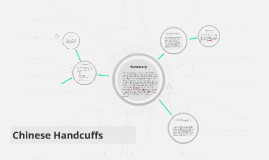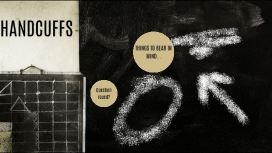Handcuffs
Transcript: Handcuffs should be stored in a loaded position, meaning that the shackle jaw should be pushed through the ratchet in the body of the cuff until it's almost through. Check that the double lock is not already engaged––this should only be operated after cuffing. Be well balanced when placing handcuffs on a person. Preferably, place the suspect off-balance while remaining balanced yourself. Do not lean the person against a surface, as is often seen on TV shows. This is a common mistake, as it gives the suspect something to use as leverage to throw him- or herself against you. Either require the suspect to stand straight up or keep the suspect unbalanced. Try to restrict the view of the person being handcuffed; not being able to see what you're doing makes it more difficult to resist with any precision Retrieve the handcuffs. Remove them from their storage place or have someone else hand them to you. Pull the person's hands behind his or her back. Alternatively, place the hands in front of the stomach. The position you choose will depend on the person's behavior, your positioning and any visible signs of a medical condition. Use best judgment on deciding whether to handcuff the person in the front or the back. Anyone who is pregnant, suffers from a serious medical condition, or is a juvenile might need to be handcuffed in the front of their body, instead of the back. Have the person place the palm facing outward with the thumb up. Hold the person's top two fingers in one hand (this gives you finger control) and hold the handcuff in your free hand, with the keyhole facing you. Push the "bow" (the part of the handcuff in which pivots to secure and un-secure a hand) between the base of the left hand and wrist bone of the person. Handcuff with the backs of hands facing each other. Now both hands should be cuffed, with the palms facing outward and the keyholes facing out too. The thumbs should both face up. Test the tightness. Slip your finger between the shackle and the handcuffed person's wrist. If you can't do this, the handcuffs are too tight.Use the double locking mechanism, if your handcuffs have one, to "double lock" the handcuffs from being tampered with. Be sure to check the cuffed area regularly. Handcuffs are a temporary restraining measure and should not be kept on someone long-term. The Four Main Types of Handcuffs The Three Basic Types of Locks 20.02.1912 - rejestracja patentu Gerge A.Carney, pojawie sie nowoczesny rodzaj kajdanek Dlaczego oni są, jakie są? $22.50 eskortowanie Handcuffs Push Pin Locks Monadnock Flex Cuffs Standard Chain Handcuffs Gdzie to uzywa dzis? $40.31 Lever Locks A key is required to double lock cuffs with push pin locks. The officer must depress the push pin, using the small peg at the top of the key. This will cause the spring to move into position and lock the bolt, preventing the cuffs from tightening pręgierz Rigid Handcuffs A key is required to double lock cuffs with slot locks as well. Officers must insert the small peg at the top of the key into the lock slot. The peg will meet the spring when the key is slid forward, causing the spring to move into position. This will lock the bolt and prevent the cuffs from tightening. These are lightweight, disposable restraints, made of plastic, that resemble electrical cable ties. Officers can carry these cuffs in large quantities, making them perfect for such situations as riots and protests. While most plastic cuffs need to be cut off of the wrists of criminals, there are some models that work with a key. Hinged Handcuffs How to Pick Your Way Out of Handcuffs Types DOUBLE CUFF Hinged handcuffs do not have a chain connecting the cuffs: Rather, they have a hinge in the middle of the cuffs that bends. Since these cuffs do not have a chain, they hold the criminal’s wrists closer together, making them more restraining. Due to the smaller size of hinged handcuffs, it can be a bit difficult for officers with large hands to handle them. MONADNOCK CUFF CUTTER 1860 - kaidanki Adams, 1y regulowany grzechotki Jak to zrobic? Chain handcuffs are by far the most commonly-used handcuffs anywhere in the world. These cuffs have a short chain attached to either cuff, and they are somewhat flexible because of the chain. Due to the flexibility of these handcuffs, it is much easier for officers to place them onto criminals. They are also excellent for officers with large hands. Rigid handcuffs are much like a mix between hinged and chained cuffs. These handcuffs have a metal bar or block connecting the cuffs, making them more flexible than hinged cuffs, but more secure than chained versions. Rigid handcuffs allow police officers to use various restraining techniques while just one hand is cuffed. This is great for criminals who are resisting arrest. Lever Lock Handcuff Demonstration Pack of 10 - $21.25 Slot Locks $19.75 Historia Gdzie sa kajdanki u policeanta? Prices zwykle kajdanki sa zastosowane wbrew woli czlowieka, np situacja policeant -przestępca

















